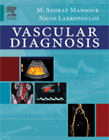|
|
|
| |
 |
|
|

|
 推薦指數:
推薦指數:





|
|
- 內容介紹
|
Vascular Diagnosis
By M. Ashraf Mansour, MD, FACS and Nicos Labropoulos, PhD, DIC, RVT
Approx. 608 pages, Approx. 450 illustrations, Copyright 2005
Description
Here’s comprehensive, in-depth coverage of the rapidly expanding field of non-invasive vascular diagnosis. Noted experts in vascular surgery, interventional radiology, cardiology, and vascular medicine explore the best approaches for vascular imaging of cerebrovascular disease, peripheral atherosclerotic occlusive disease, intra-abdominal occlusive disease, venous disorders, and aneurysms. They describe all of today’s imaging modalities and their applications for diagnosis as well as their increasingly important intraoperative and interventional roles. The book is organized into three parts. The first part covers some fundamental issues related to the vascular laboratory and principles of vascular diagnosis. The second part has five sections concerned with imaging the various regions of the body. The third part contains a collection of miscellaneous topics such as coding and reimbursement and database maintenance.
With 98 additional contributing experts
Key Features
Examines all of today’s cutting-edge technologies and techniques, including cerebrovascular color-flow scanning • laser Doppler and transcutaneous oxygen measurement • MR and CT angiography • transcranial Doppler • guiding endovascular interventions with color-flow scanning • vein graft evaluation • imaging modalities for the diagnosis of endoleaks • and ultrasound-guided filter placement.
Features a full-color design throughout and wealth of images and illustrations.
Reviews the basic and practical science that underlies the technology, such as ultrasound physics and instrumentation.
Addresses vital issues such as qualifications and competence of vascular laboratory personnel, quality assurance, and certification of the vascular laboratory as well as coding and reimbursement.
Serves as an excellent reference for both practice and exam preparation.
Table of Contents
Part I GENERAL ASPECTS
Chapter 1 The Current Role Of Vascular Diagnosis
Chapter 2 Basic Hemodynamic Principles In Vascular Disease
Chapter 3 Qualifications And Competence Of Vascular Laboratory Personnel
Chapter 4 Quality Assurance And Certification Of The Vascular Laboratory
Chapter 5 What Are We Measuring In The Vascular Patient
Chapter 6 Principles Of Ultrasound Physics And Instrumentation: An Overview
Chapter 7 The Use Of B-Flow And Power Doppler In Vascular Imaging
Part II IMAGING THE BODY
A CEREBROVASCULAR DISEASE
Chapter 8 Vascular Diagnosis In Carotid Disease
Chapter 9 Cerebrovascular Color-Flow Scanning: Technique And Applications
Chapter 10 Alternative Imaging Modalities For The Carotid Bifurcation
Chapter 11 Transcranial Doppler: Technique And Applications
Chapter 12 Evaluation Of Carotid Plaque Morphology
Chapter 13 Intraoperative Assessment Of Carotid Endarterectomy: Technique And Results
Chapter 14 Noninvasive Screening And Utility Of Carotid Wall Thickness
Chapter 15 Surveillance And Follow-Up After Carotid Endarterectomy
Chapter 16 Surveillance And Follow-Up After Carotid Angioplasty
Chapter 17 Vertebrobasilar Insufficiency: Technique And Clinical Applications
B PERIPHERAL ATHEROSCLEROTIC OCCLUSIVE DISEASE
Chapter 18 Vascular Diagnosis Of Lower Extremity Occlusive Disease: Overview
Chapter 19 Evaluation Of Claudication
Chapter 20 Physiologic Testing Of Lower Extremity Arterial Disease: Segmental Pressures, Plethysmography And Velocity Wave Forms
Chapter 21 Arterial Occlusion: Thrombotic Versus Embolic
Chapter 22 Color-Flow Scanning Of Lower Extremity Arteries: Technique And Applications
Chapter 23 Laser Doppler And Transcutaneous Oxygen Measurement: Applications In Clinical Practice
Chapter 24 Vascular Trauma: Role Of Noninvasive Testing
Chapter 25 Guiding Endovascular Interventions With Color-Flow Scanning
Chapter 26 Preoperative, Intraoperative And Postoperative Vein Graft Evaluation
Chapter 27 The Current Role Of MRA In Planning Interventions For Lower Extremity Ischemia
Chapter 27a Role of Magnetic Resonance Angiography in Peripheral Vascular Disease
Chapter 28 Congenital And Acquired Arteriovenous Fistulae
Chapter 29 Pseudoaneurysm: Diagnosis And Treatment
Chapter 30 Upper Extremity Ischemia: Diagnostic Techniques And Clinical Applications
C INTRAABDOMINAL OCCLUSIVE DISEASE
Chapter 31 Vascular Diagnosis Of Renovascular Disease
Chapter 32 Renal Artery Color-Flow Scanning: Technique And Applications
Chapter 33 Color-Flow Scanning Of The Mesenteric Arteries: Techniques And Applications
Chapter 34 Intraoperative And Postoperative Imaging Of Renal & Mesenteric Angioplasty And Bypass
D ANEURYSMS
Chapter 35 Vascular Diagnosis Of Abdominal And Peripheral Aneurysms
Chapter 36 Screening For Abdominal Aortic Aneurysms
Chapter 37 Preoperative Imaging For Open Repair Of Abdominal Aortic Aneurysm
Chapter 38 Preoperative Imaging For Endovascular Grafts: CT Angiography
Chapter 39 Imaging Modalities For The Diagnosis Of Endoleaks
Chapter 40 Postoperative Surveillance After Endovascular Repair
E VENOUS
Chapter 41 Vascular Diagnosis Of Venous Thrombosis
Chapter 42 Importance Of Color-Flow Scan Follow-Up After Deep Venous Thrombosis
Chapter 43 Vascular Diagnosis And Evaluation Of Chronic Venous Obstruction
Chapter 44 Screening And Surveillance For DVT In High Risk Patients
Chapter 45 Upper Extremity Venous Imaging
Chapter 46 Ultrasound Guided Filter Placement
PART III MISCELLANEOUS
Chapter 47 Hepatoportal System Evaluation
Chapter 48 Evaluation Of The Extremity Prior To Hemodialysis Access And Postoperative Surveillance
Chapter 49 Thoracic Outlet Syndrome
Chapter 50 Clinical Applications Of Intravascular Ultrasound
Chapter 51 Coding And Reimbursement For The Vascular Laboratory
Chapter 52 Coding And Reimbursement For Interventions And Surgical Procedures
Chapter 53 Vascular Centers: Role Of The Vascular Laboratory
Chapter 54 How To Establish And Maintain A Database
Appendix
|
|
|

